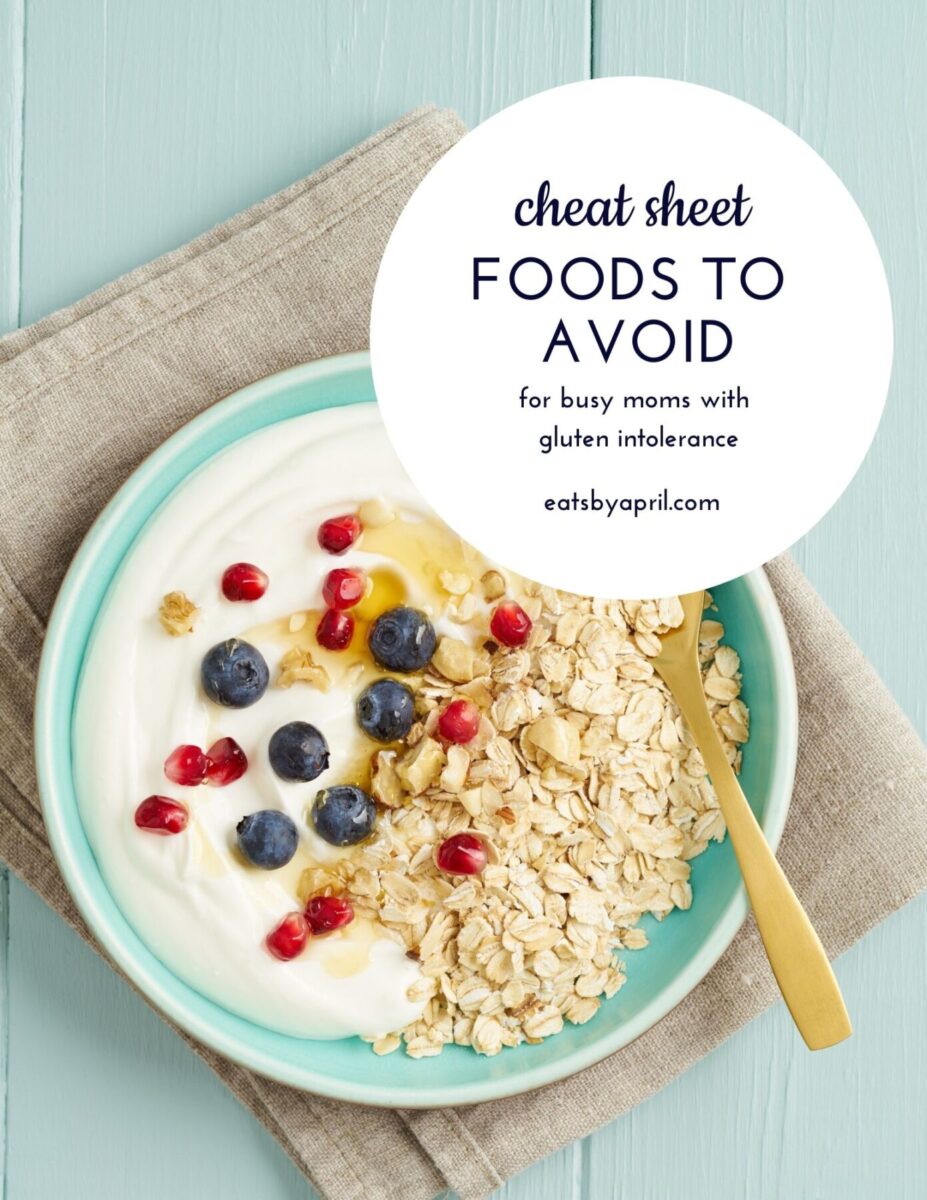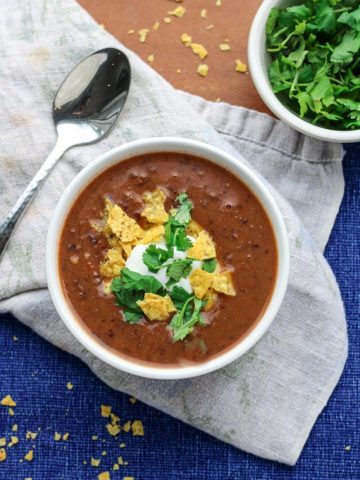When you first go gluten-free, you gotta know where gluten is found or where it could be hiding in plain sight! Barley is a sneaky one and knowing if barley is gluten-free or not will make sure you avoid gluten and gluten containing grains, like barley.

If you're just getting starting with a gluten free diet, it can be a struggle.
Knowing what you CAN eat is so tough and barley is one of those cereal grains that leaves you scratching your head, wondering if it's safe to chow down on or if it's a gluten grain in disguise.
In this blog post, we're diving headfirst into the barley and gluten debate to uncover the truth.
Let's cut through the confusion and uncover the secrets of barley's gluten content.
It's time to get real about barley and gluten – are you with me?
Let's go!
Jump to:
- ❓What is gluten?
- 📝Where is gluten found?
- 🚫Why you should avoid gluten
- 🙅♀️Is Barley Gluten Free?
- 🚫Is pearl barley gluten free?
- 📖Is barley malt extract gluten free?
- 🙋♀️Is barley malt powder gluten free?
- 🥄Is barley malt vinegar gluten free?
- ✅Gluten-free substitutes for barley
- 🍑Bottom line on gluten and barley
- Want more?
- More Resources
- 💬 Comments
❓What is gluten?
First things first: what's gluten?
Gluten is a mixture of proteins found in wheat, barley, rye. It's what gives dough its elasticity and helps bread and other baked goods maintain their shape.
For people with celiac disease, gluten sensitivity, or wheat allergy, consuming gluten can cause a whole bunch of symptoms.
Reactions to gluten can involve the immune system (celiac disease) and cause damage to the lining of the small intestine.
Symptoms of gluten intolerance or gluten sensitivity can range from digestive issues to skin rash to fatigue or "brain fog".
If you think you might be gluten intolerant, check out this post for more on the signs and symptoms of gluten intolerance or gluten sensitivity.
So, naturally, if you think you're sensitive to gluten, you're gonna want to:
- One, follow a gluten-free diet and
- Two, have a pretty good idea on which foods and ingredients are safe to consume - and which ones aren't
And unfortunately, barley is one of those ingredients that is not gluten-free.
But honestly, if you're following a gluten-free diet like I am, you won't miss it one little bit - promise🙋♀️
📝Where is gluten found?
Gluten is found in foods made from or containing wheat, barley or rye ingredients.
Grab this cheat sheet of foods to avoid so that you can avoid gluten and feel better fast!

Here's a list of the top offenders when it comes to gluten-containing foods:
- Bagels
- Bread
- Cakes
- Cereals
- Cookies
- Crackers
- Muffins
- Oats*
- Pancakes
- Pasta
- Pastries
- Tortillas
- Waffles
*Top tip: For oats, buy brands labeled "gluten-free" Regular oats can contain wheat from cross contamination in the field they’re grown in or during processing.
🚫Why you should avoid gluten
If you have celiac disease or any degree of gluten sensitivity, eating gluten can lead to a whole bunch of different health issues and discomfort.
That's why it's important to strictly avoid gluten-containing grains like barley.
The easiest way to get started with going gluten-free is to cut out any foods made from wheat, barely or rye.
Instead, focus on all the other wonderful foods you can eat - that have no gluten at all!
Get start with eating gluten free eating STAT! Go here and grab your Gluten-Free Diet Plan for Beginners now.

🙅♀️Is Barley Gluten Free?
Barley is not gluten-free. Barley contains gluten, the protein found in wheat and several other grains.
Barley has a chewy texture and slightly nutty flavour when cooked. It's used in everything from soups, stews and protein bars to food colouring and cereals.
Barley is also commonly found in foods such as barley malt, barley flours, and certain types of beer.
It's important to read labels carefully and look for gluten-free certifications or explicitly labeled gluten-free products.
🚫Is pearl barley gluten free?
You may have heard the team "pearl" or "pealed barley". Neither are gluten free.
The pearling refers to the processing methods.
Barley can be "hulled" or "pearled" before cooking and eating.
- Hulled barley, also known as whole grain barley, undergoes minimal processing. It removes the tough, inedible outermost hull, leaving the bran and germ intact. Hulled barley retains its nutrient-rich bran layer, which contains fiber, B vitamins, antioxidants, and minerals. This variety takes longer to cook compared to pearled barley because of the bran
- Pearled barley undergoes further processing. After removing the hull, it undergoes polishing or "pearling" to remove the bran layer. This process gives the barley a pearly white appearance and significantly reduces the cooking time. Like most processing, this means there's a loss in some of the nutrition found in the bran and germ. Pearled barley is a good source of dietary fiber and contains moderate levels of vitamins and minerals
But no matter if it's hulled, pearled or processed any which way, barley still contains gluten.

📖Is barley malt extract gluten free?
Barley malt extract is not considered gluten-free. Barley malt extract is derived from barley, which is a gluten-containing grain.
To make barley malt extract, manufactures soak, germinate and dry barley grains. Then the dried barley is milled into a powder or turned into a syrup through a process that involves enzymatic conversion of starches into sugars.
This syrup or powder is used as a flavouring agent in various food products such as malted milkshakes, candies, cereals, and baked goods.
While the production of barley malt extract involves enzymatic breakdown of starches, it does not remove or change the gluten proteins naturally present in barley. As a result, barley malt extract retains gluten and can potentially cause adverse reactions in individuals with celiac disease or gluten sensitivity.
Check out the label to know if a certain product has barley malt extract. Any products that have barley malt syrup added to them have it listed as an ingredient on food labels.
But the word "barley" may or may not be listed!
By law, barley as an ingredient does not have to be listed on the label.
Look for names like:
- Barley malt
- Barley malt syrup - or just "malt syrup"
- Malted barley
- Malt sugar
- Dextrimaltose
These terms let you know that the product has barley malt extract in it and as a result, is not 100% gluten-free.
And be careful with products that have "natural flavouring" or "smoke flavouring" listed as ingredients. Both of these terms can mean that barley - which means gluten is in the product.

🙋♀️Is barley malt powder gluten free?
Barley malt powder is made from barley grains, and as a result, is not gluten free.
To produce barley malt powder, manufacturers sprout, dry, and grind barley grains into a fine powder.
This powder is used as a sweetener and flavour enhancer in various foods and beverages, including malted milkshakes, baking recipes, and malted beverages.
Since barley malt powder is derived from barley, it keeps the gluten proteins naturally present in the grain. This means that it's not considered gluten-free.
Similar to barley malt syrup, the presence of barley malt syrup will be listed as an ingredient on food labels under names such as "barley malt" or "malted barley."

🥄Is barley malt vinegar gluten free?
Barley malt vinegar is not gluten-free.
Barley malt vinegar is made from fermented barley, which contains gluten.
When it comes to vinegar in general, the majority of distilled vinegar is considered safe for those following a gluten-free diet.
When it's distilled, the vinegar is heated and vaporized, and then the vapours are condensed to create the final product. This distillation process typically removes the gluten proteins, making distilled vinegar gluten-free. But here's the catch: this process does not apply to barley malt vinegar.

Barley malt vinegar is produced through the fermentation of barley, which contains gluten. The barley undergoes a malting process where it's soaked, allowed to germinate, and then dried.
During fermentation, the barley's sugars are converted into alcohol, and bacteria then convert the alcohol into acetic acid, resulting in vinegar.
As a result, the gluten from the barley remains in the final product, making barley malt vinegar not safe for those avoiding gluten.
On the plus side, there's a ton of fantastic gluten-free alternatives to barley malt vinegar available. Varieties like apple cider vinegar, rice vinegar, and wine vinegar are all gluten-free options that can be used as substitutes in recipes and dressings.
These vinegars are made from ingredients that do not contain gluten and are safe for individuals with celiac disease or gluten sensitivity to consume.

✅Gluten-free substitutes for barley
Ok so you can't eat barley or products made from barley when you have gluten intolerance or gluten sensitivity but there's so many gluten-free grains and alternatives out there.
To name a few:
- Rice - including Basmati rice, Jasmine rice and brown rice. Yes, all rice is gluten-free!
- Corn
- Quinoa
- Millet
- Gluten-free oats (certified gluten-free)
- Amaranth
And although not technically a "grain", as a dietitian, I include beans and legumes like chickpeas, black beans and lentils on this list.
These beans and legumes not only are naturally gluten-free option, they're packed with protein, healthy carbs and fibre!
Here's a few recipes featuring some of those awesome gluten-free grains and legumes:
🍑Bottom line on gluten and barley
Although barley is a grain that contains gluten, there are so many more healthy grain options for those of us looking to avoid gluten and have a nutritious gluten free diet. Jump into the world of healthy gluten free eating by joining in with me!
Want more?
Sign-up to get all the healthy and gluten-free recipes delivered straight to your inbox each week.
"*" indicates required fields













Brian Haarer says
Thanks for the info however, quinoa and amaranth are "pseudo-grains" and, as do most grains, beans (unless properly cooked), legumes and seeds, they contain lectins. Lectins are plant-based proteins which are largely to blame for the "discomfort" some people experience, as well as a whole host of other maladies. Millet and sorghum are acceptable substitutes. Many fruits and vegetables are also "culprits"...although this is relatively new info to the "nutritional" community, it bares more research and behooves one to find out more, as I am certain that many of your followers suffer from the ill-effects of these proteins. I am also quite certain that your followers will benefit from this new info, and in return, will sing your praises! Good luck and good health.
Thank you so much Brian for your comment. I have never tried millet or sorghum and would like to look into it as it's great to have more gluten-free grains to choose from. Really appreciate it.
All the best,
April